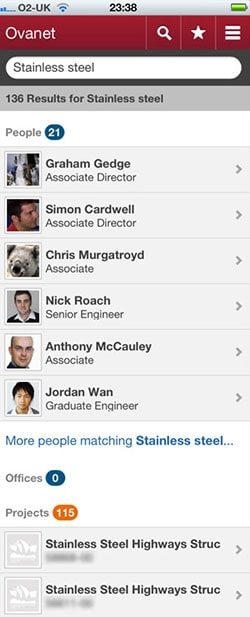Filed under: Digital workplace, Intranets, Mobile, Usability
Enterprise software applications aren’t “designed”. At best, they’re “developed”, but often they’re just “built”.
Whether provided by a software vendor, or created in-house, enterprise solutions are heavy on developers, and it shows. There may be a number of BAs involved, but typically not UX folk or designers. The result are solution that at best meet a business need, but are often ugly, complex and hard to use. (Think any of the ERP or ESS solutions.)
Designing mobility

Beautifully designed mobile search is more than just a shrunk copy of the desktop experience. Screenshot courtesy of Arup.
In contrast, mobile solutions are designed. This is perhaps the greatest impact of Apple (and others) — to re-introduce the world to the power (and profit) of design. While not all mobile apps are universally good, the vast majority demonstrate that the creators put care and attention into how the apps look and work.
What we’re seeing is that this presents a big opportunity in the enterprise space.
Up to this point, even the best-designed intranet is forced to link to poorly-designed enterprise systems for HR, finance and IT (and beyond). There is little scope to deliver a more seamless experience, and organisations often struggle with even the basics, such as single sign on.
The constraints and demands of mobility can mandate a certain level of design. This leads to more usable, efficient (and beautiful) solutions.
The solutions delivered by Judge Group and Arup (Gold winner and commended in this year’s Intranet Innovation Awards) show the benefits of a design-lead approach.
In the case of Judge, they used (and sometimes built) APIs for enterprise systems to provide a remarkably simple interface for staff (one-click access to your leave balance anyone?). At Arup, their responsive design approach to their project database and enterprise search is a joy to behold.
Making it happen
In practice, applying design to enterprise mobility includes:
- Understanding staff needs deeply, through field research.
- Applying “designing thinking” to re-imagine how best to meet staff needs.
- Using strong UX techniques and concepts to deliver usable and effective interfaces.
- Creating elegant and engaging user interfaces that natively match mobile devices.
To a certain extent, both Arup and Judge had the benefits of being developed “under the radar”, without the direct involvement of corporate IT. This gave more scope for rethinking how to deliver user-driven solutions.
More broadly, there is a narrow window of opportunity to cement the importance of design in the enterprise mobility space. That way, when mobility becomes the domain of the “big boys”, the precedent has already been set.
So let’s get designing!




